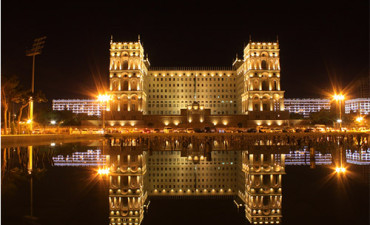The Christian Heritage of Azerbaijan
The Christian heritage of Azerbaijan is deeply rooted in its ancient history and has played a significant role in shaping the country. Christianity first arrived in the region during the first century AD through the efforts of early Christian apostles, including Bartholomew and Thaddeus.
Among the notable Christian sites in Azerbaijan is the Albanian Church, also known as the Church of Kish. Situated in the village of Kish in the Sheki region, this ancient church is believed to date back to the 1st century AD and represents the heritage of the Caucasian Albanians, an ancient Christian nation that once inhabited the area.
While Christianity thrived in the Caucasian Albania, encompassing parts of present-day Azerbaijan, its prominence gradually declined with the arrival of Islam in the 7th century. Over time, a majority of the population converted to Islam, resulting in a predominantly Muslim population in Azerbaijan today.
Despite the dominance of Islam, Azerbaijan is home to various Christian communities. The Russian Orthodox Church, Georgian Orthodox Church are among the Christian denominations represented in the country. Additionally, there are Catholic and Protestant communities as well.
The Azerbaijani government recognizes and respects religious diversity, ensuring that Christians and other religious groups are free to practice their faith. Several historical Christian sites and churches have been preserved and restored, serving as important cultural and historical landmarks.
It's worth noting that Azerbaijan's religious landscape encompasses a range of faiths, with Islam being the dominant religion followed by the majority of the population. However, the country's rich cultural heritage includes Christianity, Judaism, and other religions, reflecting its diverse historical tapestry.
Church of Kish

Situated in the picturesque village of Kish in Azerbaijan, the Church of Kish stands as a testament to the region's abundant Christian heritage. Its origins trace back to the 12th century, making it one of the oldest Christian churches in the country. This historic landmark has emerged as a symbol of tremendous cultural and historical importance.
The Church of Kish boasts a distinctive architectural style, harmoniously combining elements from both Eastern and Western traditions. Its exterior mesmerizes with intricate stonework and exquisite carvings that embellish the walls and facade. These remarkable designs showcase the influence of Byzantine, Persian, and Caucasian architectural styles, representing the intermingling of diverse periods.
Despite its considerable age, the Church of Kish has been remarkably well-preserved throughout the centuries, thanks to meticulous restoration efforts. This careful restoration work ensures that visitors can experience the church's awe-inspiring beauty and immerse themselves in its profound historical significance. By exploring the Church of Kish, one can truly appreciate the enduring legacy of Christianity in Azerbaijan and the profound impact it has had on the region's cultural fabric. You can visit the ruins of St. Bartholomew Church as part of our Gabala-Sheki Tour.
Church of Saint Elisaeus in Nij Settlement
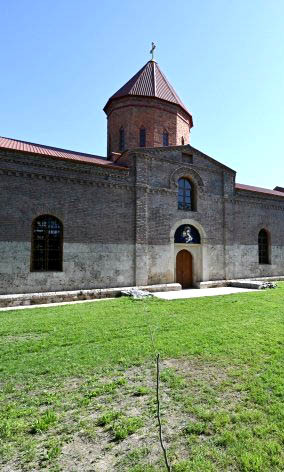
One notable church in the Nij settlement of Gabala belongs to the Udi people, an ancient Caucasian ethnic group. This church, built in 1823 by the local Udi priest Astvatzatur Jotaniants, holds significant historical value. It stands on the gravesite and chapel of Vlas the Martyr, a devoted disciple of Saint Elysaeus. The local community repaired the church in 1879, showcasing their commitment to preserving their Christian heritage.
The Udi people have a rich history dating back to 5 BC, and today, they represent a small population of only a few thousand worldwide. The majority of Udi people, around 4,000 individuals, reside in the village of Nij in Azerbaijan.
The Udi church stands as a symbol of the Udi people's unwavering devotion to Orthodox Christianity. Through renovations, the church has been restored to its former glory and continues to serve as an active place of worship. The Udi community takes pride in preserving their unique language and cultural practices, which existed long before the advent of Christianity. Among these practices are the eternal flame burning within the church and the significance they attribute to the moon.
Seven Church monastery complex

Yeddi Kilse is an architectural complex consisting of several religious structures located near the village of Lekit in the Gakh District of Azerbaijan, on the way to Lekit-Kötüklyu village and 12 kilometers from the village of Kah-bash. According to the decree of the Cabinet of Ministers of Azerbaijan on historical and cultural monuments, this complex is recognized as a locally significant architectural heritage site.
Despite being commonly known as "Yeddi Kilse" or "Seven Churches" in the local community, the complex actually contains remnants of nine structures. Some researchers suggest that these may be mausoleum-chapels possibly built in 4th-5th centuries. In the upper monastery of Yddi Kilse, there was an underground burial chamber. The ruins of numerous architectural structures indicate that Lekit might have been a center of the bishopric in the Albanian Church.
Kurmuk Church in Gakh
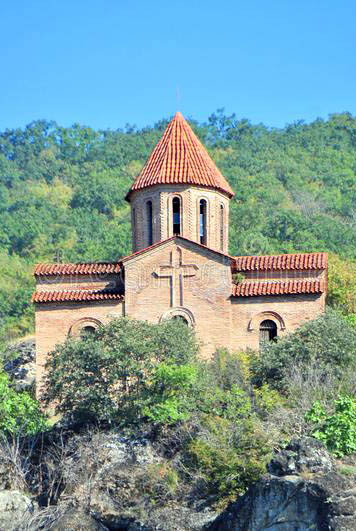
Kurmuk Church, also known as the Church of St. George, is a church built in the 19th century by the Russian Empire on the remnants of an ancient Albanian temple (dating back to the 1st-3rd centuries) in the Gakh District of Azerbaijan, with the purpose of Christianizing the region and establishing a religious base. In September 2006, archaeological excavations conducted in the southern part of the church revealed that it underwent reconstruction and restoration four times over the course of four centuries. These excavations in the area confirmed that the church was built on the remains of an ancient temple.
The name of the church is first mentioned in Georgian sources in 1310 when it was visited by Georgian Patriarch Evktime III (1310-1325). The church was destroyed during the campaign of Shah Abbas between 1614-1617. Later, the Russian Empire, which occupied the Ilisu Sultanate, built a new church on the remains of the ancient temple through the "Administration for the Restoration of Christianity in the Caucasus" to spread Christianity. The restoration of the church began in 1891 and was completed in 1894. You can visit Kurmuk Church during our Gabala-Sheki-Gakh 3 Days, 2 Nights Tour.
St. John's Church in Goygol

Saint John's Church, also known as Johanniskirche in German, holds great significance as Azerbaijan's first German Lutheran church. Located in the town of Helenendorf, its rich history is deeply intertwined with the Christian heritage of Azerbaijan.
The origins of the church trace back to 1817 when numerous Swabian Lutheran pietist families migrated to the Russian Empire with the permission of Emperor Alexander I. Among these families, approximately 700 settled in Transcaucasia, eventually establishing the colony of Helenendorf. As the community grew, the need for a place of worship became evident, leading to the construction of the church. On April 24, 1854, the foundation stone was laid adjacent to a parish school, and the church was consecrated and opened to the public on March 10, 1857.
In 1941, after the deportation of Germans from the region, the church was repurposed as a sports hall and later as a military hospital. It was renovated in 2008 with support from the German GIZ and now serves as the History-ethnography museum of Goygol.
Saint Bartholomew Church
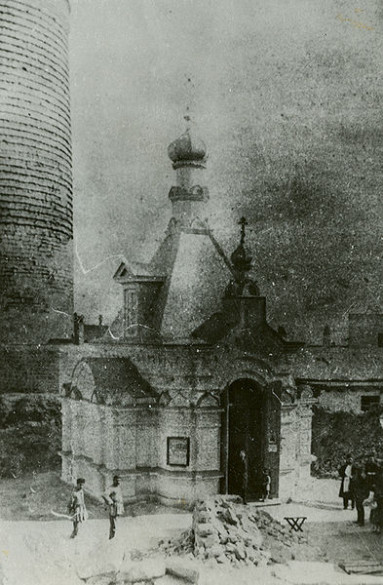
St. Bartholomew Church, an integral part of Azerbaijan's Christian heritage, was erected in 1892 with contributions from the local Christian community. It stands on the hallowed ground where the Apostle Bartholomew is believed to have met his martyrdom, underscoring the historical significance of Christianity in Azerbaijan.
This cherished orthodox church, designed by architect Johann Edel in the style reminiscent of Russian churches, adorned its interior with exquisite icons depicting Bartholomew and other revered saints. Interestingly, it was built upon the foundations of Baku's first and oldest church, further accentuating the enduring Christian legacy in the region. Sadly, the church fell victim to the anti-religious campaign and was demolished in 1936, reflecting the challenges faced by the Christian community during that period.
Even today, Azerbaijan pays tribute to St. Bartholomew on his remembrance day, June 24, with the Baku diocese conducting a solemn moleben at the site where the church once stood. In 2003, the esteemed Patriarch Bartholomew I of Constantinople presented a precious gift to Azerbaijani Christians - some of the remains of St. Bartholomew, which are now safeguarded within the Holy Myrrhbearers Cathedral. Notably, the remnants of St. Bartholomew's Church have been officially recognized as an archaeological monument since 2015, emphasizing their historical and cultural significance in Azerbaijan's Christian heritage. You can visit the ruins of St. Bartholomew Church as part of our Old City Tour.
Holy Myrrhbearers Cathedral

The Holy Myrrhbearers Cathedral holds a significant place in the Christian heritage of Azerbaijan. this magnificent structure was constructed according to a standard design for military churches authorized by the Construction Commission in 1901. During the time of the Russian Empire, as many as 64 similar churches were erected. Serving as a place of worship for the 206th Salian Infantry Regiment stationed in Baku, the cathedral was established in 1908.
The cathedral regained a new life thanks to the attention and support of Azerbaijani entrepreneur Aydin Gurbanov. With his funds, comprehensive repair and restoration works were carried out in the cathedral, including the construction of a stone carved iconostasis, frescoes, and the acquisition of necessary church utensils. After the repair and restoration works, the renovated cathedral was officially opened on March 24, 2003. The ceremony was attended by President of Azerbaijan Heydar Aliyev.
Recent Posts

Buy any tour and get 15 percent discount in Baku restaurants
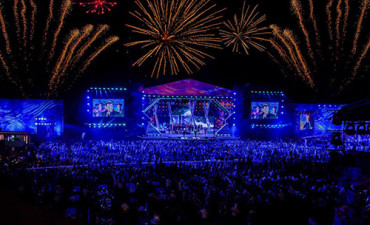
Festivals In Azerbaijan

Great Silk Road In Azerbaijan

Guide to outdoor activities
